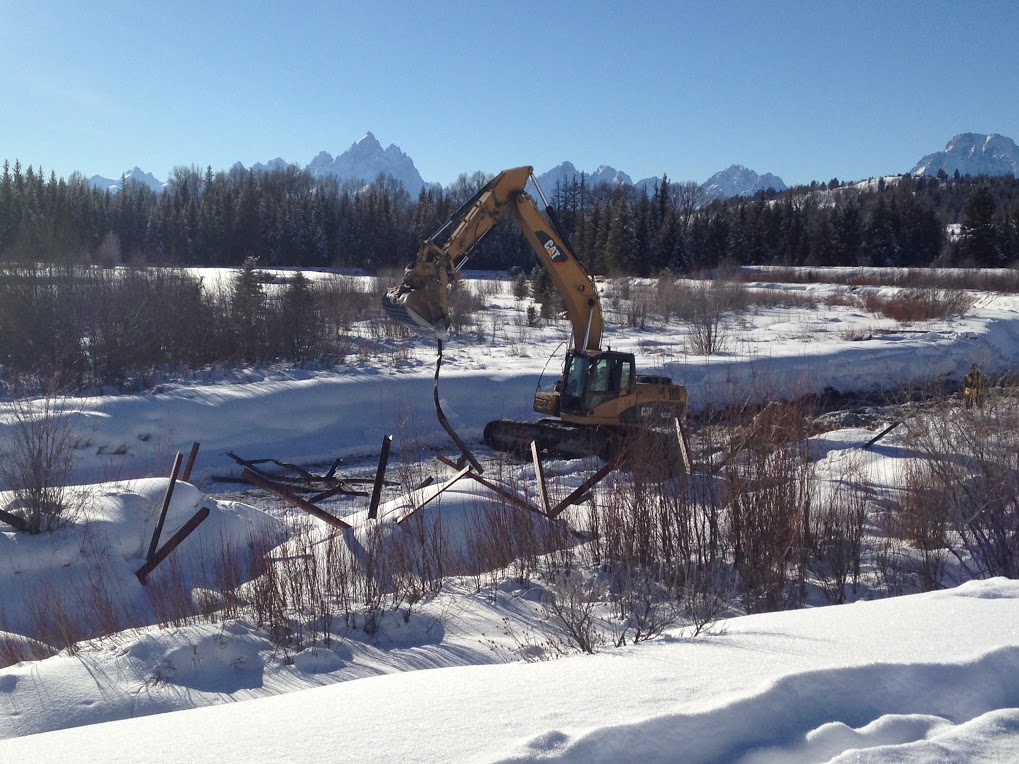|
You are viewing ARCHIVED content published online before January 20, 2025.
Please note that this content is NOT UPDATED, and links may not work. For current information,
visit https://www.nps.gov/aboutus/news/index.htm.

Photo by: Elizabeth Barrett
Contact: Public Affairs Office, 307.739.3393 This week, Grand Teton National Park advanced a riverbank restoration project to remove approximately 13 tons of old angle iron beams from the Buffalo Fork of the Snake River. Motorists traveling Highway 26/287 past Moran Junction may see a piece of heavy equipment—a tracked excavator—along the riverbank as this restoration project continues. In 1958, a series of iron beams were placed along the north bank of the Buffalo Fork River by the U.S. Department of Commerce, Bureau of Public Roads, as part of a stabilization and erosion control project to protect Highway 26/287 from potential flooding. Over the years, the main channel of the river has gradually shifted southward, rendering the decades-old structure obsolete for erosion control. Currently, the large angle iron pieces obstruct wildlife movement through an important riparian area and diminish the natural quality and character of the Buffalo Fork, a major tributary of the Snake River that was designated as a Wild and Scenic River in 2009. As they became more noticeable and unsightly over time, the presence of the iron beams caught the interest of Giovanni Tabacchi, one of Grand Teton's river patrol rangers. Tabacchi proposed a removal and restoration project and brought his request to the park's resource council committee and park managers. In response, park resource managers requested an assessment by a professional hydrologist as to the necessity for these iron beams and their associated tangle of cables and wires. The hydrologist determined that the apparatus no longer provided a functional purpose and instead, posed an unnecessary hazard to the Buffalo Fork riparian corridor. Grand Teton proposed the removal of these structures in its Snake River Headwaters Comprehensive River Management Plan, completed in 2014. Shortly after, permits were obtained from the Army Corps of Engineers and Wyoming Department of Environmental Quality, and a restoration effort was launched. In the summer of 2014, a volunteer group coordinated by the Jackson Hole Wildlife Foundation (JHWF) removed all the cable and wiring that connected the metal beams together, and they unbolted the angle iron tripods. The extensive volunteer work was a first tangible step in implementing the restoration effort. "It was a labor intensive project that saved the higher cost of having this done through a contractor," said Greg Griffith, JHWF's lead for this volunteer project. "More importantly, there was an immediate benefit because it opened up a quarter mile of the riparian corridor by reducing a waterfowl collision hazard and by eliminating an impermeable combination of wires, cables and metal tripods to enable the movement of moose, elk, mule deer and other wildlife through this key riparian habitat," added Griffith. The JHWF has partnered with Grand Teton and others for two decades to remove or modify more than 170 miles of fencing to benefit wildlife in the park and other valley lands. Ridgeline Excavation of Jackson, Wyoming was contracted to do the "heavy lifting" portion of the project and is now removing nearly 13 tons of the angle iron beams using the tracked excavator. This portion of the restoration project was greatly aided by the volunteers' work to remove the cables, wiring and tripod bolts. The angle iron pieces will be recycled as scrap metal after their removal. The contracted restoration work is taking place during the winter, when the ground is frozen and snow-covered, to minimize environmental impacts to the sensitive riparian habitat. Ice bridges have been constructed to support the tracked excavator and reduce impacts to vegetation and soils. In the final phase of the project, JHWF volunteers will return to help the park remove and recycle any remaining metal pieces, and park biologists will plant native willow and alder to accelerate natural regrowth of the disturbed site. The Buffalo Fork project is the third in a series of recent riparian restoration projects that benefit park resources. In the fall of 2010, Grand Teton worked with Trout Unlimited and other partners to remove the Spread Creek Dam, and in 2013 removed the Newbold Dam near Kelly, also with help from Trout Unlimited. Each of those projects improved fish habitat and passage on tributaries of the Wild and Scenic Snake River. "Projects that restore terrestrial and riparian habitats are central to our NPS mission to protect and conserve natural resources for the benefit of future generations," said Grand Teton National Park Superintendent David Vela. "Often, we cannot accomplish large-scale habitat restoration projects without the help of willing partners, such as the Jackson Hole Wildlife Foundation and Trout Unlimited. We greatly value and appreciate our collaboration with these conservation-focused groups, and look forward to other opportunities where we can work together in the protection of critical park resources." |
Last updated: February 24, 2015
